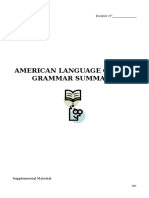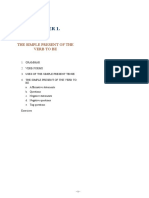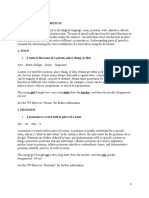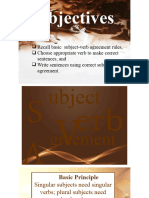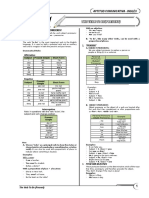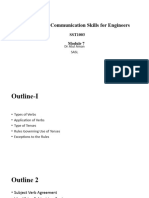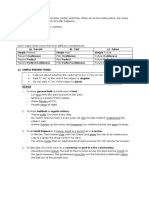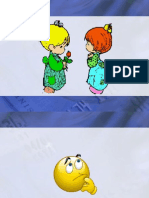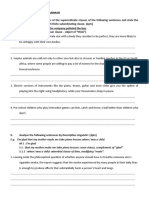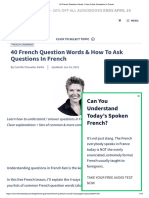0 ratings0% found this document useful (0 votes)
51 viewsCommon and Proper Nouns
This document contains a summary of 3 key points:
1. It provides details about a class including the course instructor, Firdaus S.S. M.Pd.Bi, and lists 4 students enrolled in the class: Surya, Tiara, Munalisa, and Mawar studying at the TBI program.
2. It discusses the use of common nouns versus proper nouns, and the use of the definite article "the" with proper nouns.
3. It provides examples of simple sentences and discusses subject-verb agreement, including situations like collective nouns, compound subjects, and plural/singular verbs.
Uploaded by
daien quequeCopyright
© © All Rights Reserved
We take content rights seriously. If you suspect this is your content, claim it here.
Available Formats
Download as PPTX, PDF, TXT or read online on Scribd
0 ratings0% found this document useful (0 votes)
51 viewsCommon and Proper Nouns
This document contains a summary of 3 key points:
1. It provides details about a class including the course instructor, Firdaus S.S. M.Pd.Bi, and lists 4 students enrolled in the class: Surya, Tiara, Munalisa, and Mawar studying at the TBI program.
2. It discusses the use of common nouns versus proper nouns, and the use of the definite article "the" with proper nouns.
3. It provides examples of simple sentences and discusses subject-verb agreement, including situations like collective nouns, compound subjects, and plural/singular verbs.
Uploaded by
daien quequeCopyright
© © All Rights Reserved
We take content rights seriously. If you suspect this is your content, claim it here.
Available Formats
Download as PPTX, PDF, TXT or read online on Scribd
You are on page 1/ 16
UNIT 3
Dosen pengampu: Firdaus S.S. M.Pd.Bi
Nama anggota:
1. Surya faturrahman (2113007)
2. Tiara (2113002)
3. Munalisa (2113012)
4. Mawar herpiana (2113018)
Prodi: TBI
Kelas: A
USE OF COMMON SENTENCES AND
PROPERS NOUNS
The use of common nouns when there is a general
situasion, general activity. Because common nouns are
general, so the use of the word is general.
The use of propers nouns when there are general
situasions, but propers noun are spesific and add the
word “the”.
USE OF THE DEFINITE ARTICLE “THE”
IN PROPER NOUNS
There are several conditions that need to be fulfilled
by the word “the” before using a proper nouns
1. before geographic name
2. before pluralized name
3. before the spesific name
4. before noun
EXAMPLE COMMON AND PROPER
NOUNS
1. The kids on the school bus were making loud noises
2. Jenny was using bad language too
3. The poor driver was unhappy
4. The kids were going to skyline school
5. The teachers were waiting in the parking lot
6. With all the noise, betty, the driver, was distracted
VERB “TO BE”
Verb "to be" is one of the substitutes or complements of
verbs that are widely used in English sentences. Like
the words, am, is, were, was, be, been, being Even the
verb "to be" also has a change of form according to the
tenses of the sentence (present, past, or future) or
from the aspect of changing the verb (simple, perfect,
or continuous).
FUNCTION “TO BE”
Verb "to be" can be divided into two, namely as a linking
verb and as an auxiliary verb.
• Linking verb
Linking verbs are verbs that are used to connect the subject of a
sentence with the explanation or information (complement). The
explanation or information provided can be in the form of an
adjective (adjective), noun (noun), or adverb (adverb).
examples sentences linking verb :
1. You are my friend
2. These kittens are so cute
3. She is with me
FUNCTION “TO BE”
Auxiliary verb
The auxiliary verb “to be” can be used together with the present
participle to form the continuous/progressive form. It can also be used
in conjunction with the past participle to form a passive sentence. In
addition, in some tenses, the verb "to be" can be combined with other
auxiliary (primary or modal).
Examples sentences auxiliary verb:
1. Adi is playing football right now
2. Your room was cleaned this morning
3. I have been waiting for you arrival
EXAMPLES VERB “TO BE” TO MAKE A
QUESTION
Examples verb “to be” yes/no question
Are you a pilot?
Were you playing football yesterday?
Are you happy now?
Is she with you?
Example verb “to be” question tag
She is with you, isn’t he?
You weren’t playing football yesterday, were you?
She was smlling at me, wasn’t he?
That woman is kind, isn’t he?
SIMPLE SENTENCES
Simple sentences are the most basic sentences in English. It
consists of one independent clause only. A complete simple
sentence consists of a subject and a predicate. A simple
sentence can be long or short, but the important thing is that
it has a group of words with the correct grammatical
structure.
Simple sentences must also be understood by those who read
them. Remember, simple sentences in English start with a
capital letter and end with a period. It is very important to
know what a correct sentence looks like so that we can know
whether the sentence is complete or not. Then, we can also
add punctuation correctly.
FUNCTION SIMPLE SENTENCES
writing a simple sentence that is correct then we can
convey whatever we want. Readers of our sentences
will also more easily digest what has been conveyed.
With simple sentences, we can express various
expressions, opinions or ideas from easy to difficult
levels.
Formula Simple sentences
There are various types of simple sentences. Here are
the types of simple sentences:
1. Subject + verb, example: the girls cries
2. subject + verb + object: She blows the balloons
3. Subject + verb + adjective: Hendri was cruel
4. Subject + verb + adverb: We are going now
5. Subject + verb + noun: We paint walls
Subject-verb Agreement
Subject verb agreement is the adjustment of verb
(verb) and subject (subject) of a sentence, whether it is
singular or plural subject. Subjects can be nouns,
pronouns and others.
adjustment between the verb (verb) and the subject of
a sentence in terms of number, namely: singular
(singular) or plural (plural).
Basically, singular subject (single subject) uses a
singular verb (singular verb), while plural subject
(plural subject) uses a plural verb (plural verbs).
USE SUBJECT-VERB AGREEMENT
In general, in the simple present tense, singular verbs
are in the base form or bare infinitive (the basic form
of the verb) with the ending -s or -es added.
Subject-verb agreement becomes confusing when
faced with issues such as: the subject is a collective
noun, a compound subject, a plural form with a
singular meaning, and an indefinite pronoun.
COLLECTIVE NOUN
Is a noun used to express the name of a group
(consisting of more than one member)
As a subject, this noun can be singular or plural
depending on the context. If group members do the
same thing simultaneously, then this noun is
considered as a subject unit with a singular verb.
Examples: The team is going on holiday now
The team are going on holiday now
COMPOUND SUBJECT
A compound sentence is two subjects that are in one sentence.
There are several conditions to determine when we change the verb to be
plural or singular:
1. If two or more subjects, both singular and plural, are connected by
the coordinating conjunction "and", then the plural verb is used.
Example: Ichel and her brother go to school by bus.
2. If two or more singular subjects are connected by “or” or “nor”, a
singular verb is used. The opposite applies to plural subjects.
Example: To stay or to go is your prerogative.
3. If the compound subject consists of positive and negative subjects
(singular or plural), the verb follows the positive. Example: The staff
but not the manager have received their salaries.
THANK YOU
You might also like
- First-Year Polish. Pierwszy Rok Języka Polskiego by Swan Oscar E.100% (2)First-Year Polish. Pierwszy Rok Języka Polskiego by Swan Oscar E.598 pages
- Lab Bhs Inggris 1 (Grammar and Speaking)No ratings yetLab Bhs Inggris 1 (Grammar and Speaking)42 pages
- Professional Communication Skills For Engineers: DR Atul Aman SaslNo ratings yetProfessional Communication Skills For Engineers: DR Atul Aman Sasl16 pages
- 7th Grade English / Language Arts CRCT ReviewNo ratings yet7th Grade English / Language Arts CRCT Review12 pages
- A) Simple Present Tense: A) Present B) Past C) Future Simple Present Simple Past Simple FutureNo ratings yetA) Simple Present Tense: A) Present B) Past C) Future Simple Present Simple Past Simple Future5 pages
- SH, CH, X, SS, Z and o and Before There Is A Consonant We Change y ForNo ratings yetSH, CH, X, SS, Z and o and Before There Is A Consonant We Change y For4 pages
- FALLSEMFY2023-24 BSTS201P SS CH2023241700237 Reference Material I 25-10-2023 L24 - Subject-Verb AgreementNo ratings yetFALLSEMFY2023-24 BSTS201P SS CH2023241700237 Reference Material I 25-10-2023 L24 - Subject-Verb Agreement33 pages
- Subject-Verb Agreement: Agreement of Subjects and VerbsNo ratings yetSubject-Verb Agreement: Agreement of Subjects and Verbs4 pages
- How To Write A Simple Sentence: Lesson Objective100% (2)How To Write A Simple Sentence: Lesson Objective17 pages
- Using Verbs When Giving Information and ExplanationsNo ratings yetUsing Verbs When Giving Information and Explanations34 pages
- 1727317489095.Unit 1 Communication Skills Class 9 Questions and AnswersNo ratings yet1727317489095.Unit 1 Communication Skills Class 9 Questions and Answers5 pages
- Preview of Collins Easy Learning Grammar and PunctuationNo ratings yetPreview of Collins Easy Learning Grammar and Punctuation10 pages
- Combine the Sentences to Form Compound SentencesNo ratings yetCombine the Sentences to Form Compound Sentences4 pages
- Conditional Sentences, If-Clauses Type I, II, III PDFNo ratings yetConditional Sentences, If-Clauses Type I, II, III PDF7 pages
- MABS 67 1 Reading in Pali-Sutta I Grammatical Foundation L1No ratings yetMABS 67 1 Reading in Pali-Sutta I Grammatical Foundation L161 pages
- 40 French Question Words + How To Ask Questions in FrenchNo ratings yet40 French Question Words + How To Ask Questions in French15 pages
- Unified International English Olympiad: SyllabusNo ratings yetUnified International English Olympiad: Syllabus4 pages


